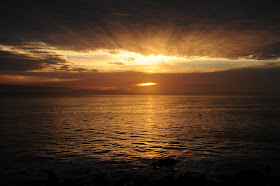Today, we set out to pop the jacket that we made yesterday afternoon. While the humidity from the night before dried, some of us kept working on smaller or isolated bones. Others went to town to make phone calls and arrange accommodations for our stops on the way back to Ensenada the next day.
It was a lovely morning to dig bones, as well as for surfing (you can see a surfer to the right). Daryl and Ehecatl take care of some isolated elements while the jacket dries.
We started digging around the jacket with our picks and hammers to remove it. One of the locals, Cal, offered to help us with more advanced technology.
The jacket, popped and ready for capping. This and all the other fossils we collected will go to the Universidad Autónoma de Baja California Sur. Later this year, hopefully, we'll get some of the material on loan so we can start describing it and publishing on the interesting finds that resulted from this trip.
After one last look at the bay we headed out to begin our four day trip back, first to Ensenada, then to Los Angeles.
For past entries of this series:
Dispatches from the field: Baja California, Pt. 7
Fieldwork in Baja California was made possible through an NSF EAR
grant to D. P. Domning & L. G. Barnes. The text in these posts reflect my own opinion and not those
of the granting agency or institutions to which I’m affiliated.
































